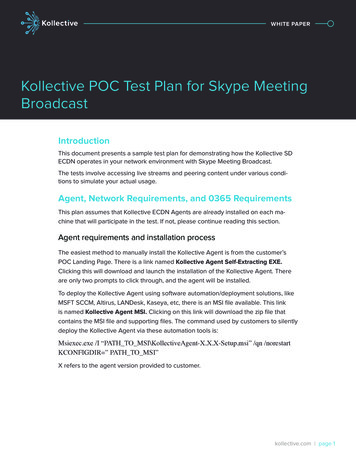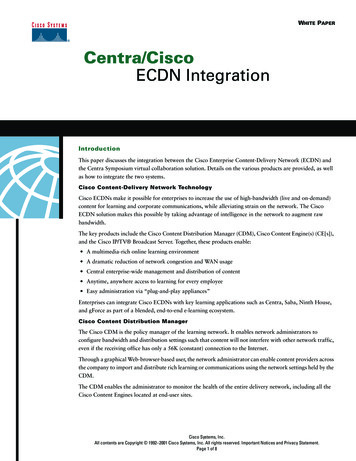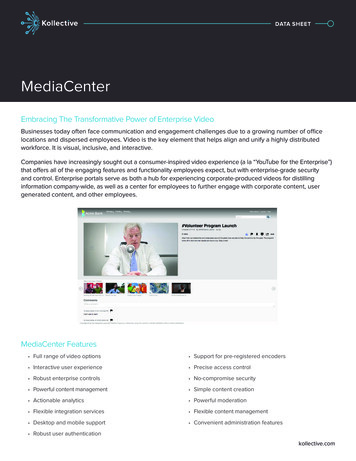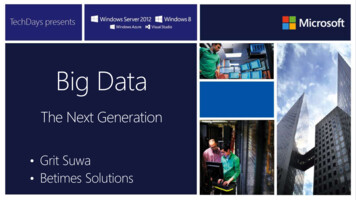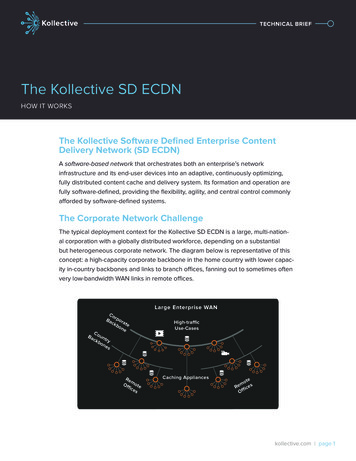
Transcription
TECHNICALWHITE PAPERBRIEFTitle Kollective SD ECDNTheBILINEIT WORKSHOWThe Kollective Software Defined Enterprise ContentDelivery Network (SD ECDN)A software-based network that orchestrates both an enterprise’s networkinfrastructure and its end-user devices into an adaptive, continuously optimizing,fully distributed content cache and delivery system. Its formation and operation arefully software-defined, providing the flexibility, agility, and central control commonlyafforded by software-defined systems.The Corporate Network ChallengeThe typical deployment context for the Kollective SD ECDN is a large, multi-national corporation with a globally distributed workforce, depending on a substantialbut heterogeneous corporate network. The diagram below is representative of thisconcept: a high-capacity corporate backbone in the home country with lower capacity in-country backbones and links to branch offices, fanning out to sometimes oftenvery low-bandwidth WAN links in remote offices.Large Enterprise WANCoBa rporck ateboneCBa ounck trybonesRemOffi otecesHigh-trafficUse-CasesCaching AppliancestemoRe cesOffikollective.com page 1
As more and more business functions become IP-based, demands on a corporatenetwork’s capacity increase to the point where the network is a constraining andcontested resource. Some scenarios that are particularly problematic include: therelease of a new training video on an internal portal that will be in high demand inthe branch offices, or an important all-hands webcast from the CEO. These generate substantial “north-south” traffic, from the backbones out to the edge, which caneasily result in saturated WAN links and the disruption of critical business functions.These practices are often either banned outright, or require the purchase and deployment of many expensive hardware caches, WAN optimizers, streaming-serverrepeaters and other devices to reduce this north-south traffic over congested WANlinks.The Kollective Difference: Unique and Efficient SoftwareDeliveryThe Kollective SD ECDN addresses these content-delivery challenges entirely withsoftware, leveraging existing network infrastructure, as well as latent but generallyunused capacity in the broader infrastructure, notably storage and serving bandwidthon end-user devices, to easily handle these cases. The Kollective SD ECDN is a setof Kollective-managed, cloud-hosted control and origin servers and a small softwareagent deployed on employee devices throughout the company, as shown below.Kollective ECDNCoBa rporck ateboneCBa ounck trybonesOriginPubDirRemOffi otecestemoRe cesOffiKollective Software AgentsThe central servers and the agents collectively form an adaptive and distributedcontent delivery and caching system to ensure that upwards of 99% of contentis delivered via controlled, localized, traffic that doesn’t congest WAN links. All ofthese software components cooperate to deliver content, secure it via a multi-layeredcrypto framework, and form an optimal delivery overlay mesh that dynamically adaptsto network changes. All aspects of its operation are software-defined.kollective.com page 2
Kollective SD ECDN Architecture and Key ComponentsThe Kollective SD ECDN architecture exhibits a classical three-layer SD structure:1. An Application Layer comprising management, analytics and contentapplications, all built on a set of north-bound APIs provided by the secondlayer.2. A Control Layer that centrally orchestrates and manages the network.It provides the high-level API for the application layer and uses a commonset of south-bound protocols to manage the third layer.3. A Data Layer comprising all the components that are used to form theKollective SD ECDN’s network - a small number of central, cloud-basedKollective head-end servers, the existing corporate network itself, plus theend-user devices running the Kollective agent.The top two layers, Application and Control, and portions of the Data layer, arehosted in the Kollective Cloud providing a fully-managed SaaS solution, only theKollective agent needs to be deployed on end-user devices within the enterprise.ECDN Optimization &Diagnostics AppsECDN Management &Control AppsNetwork ReadinessTestingManagement API3rd-Party IntegrationsSkype Meeting BroadcastTeams, SCCM, Sharepoint,YammerApp Layer(Cloud)Application APIControl Layer(Cloud)ECDN ControllerEnterpriseIdentitySystemKollective Software-Defined NetworkData Layer(Software)SECURITY FRAMEWORKThe Application Layer contains:Management and control applications used to manage and monitor SDECDN operation and orchestrate per-enterprise network policies and operational rules. There are over 250 software controlled parameters coveringthese policies and rules, ranging from protocol and port preferences, throughhierarchical location and device group definitions, in order to provide full control of network formation and traffic patterns, as well as bandwidth, disk andCPU use caps for individual end-user devices.Delivery monitoring and readiness-testing applications providing exhaustive pre-flight and post-flight analytics. The network readiness testing application is a unique aspect of the Kollective SD ECDN, taking advantage ofthe deployed agents to perform automatic and invisible delivery testing. Thisprovides crucial feedback and operational confidence prior to an importantdelivery event, such as a live CEO webcast.kollective.com page 3
The Control Layer contains:Network directory servers that keep track of the delivery network topologyand content disposition within the network. They provide key delivery-meshformation intelligence to the network as a whole.Agent Directors that monitor and manage the agents, pushing any agentspecific software-defined network controls out to the agents, managing automated subscription and targeted deliveries and assisting the network readiness-test system in orchestrating agent test sets and runs.A Content Management System that provides fully authenticated contentingestion, transcoding, encryption, metadata and access controls. This systemintegrates with an enterprise’s authentication servers to provide enterprisedirectory-compliant content access controls.Live video stream ingest endpoints that can operate in either push or pullmode using either external encoders or other live video streams, conditioningand directing the streams for delivery out through the Kollective SD ECDN.Network readiness-test managers that are used to set up and monitorpre-flight readiness tests. These allow various kinds of delivery events tobe tested using either explicitly selected sets or statistically sampled setsof end-user devices.SD ECDN status and monitoring servers that take in constant status andmonitoring data from all the components, enabling monitoring and analyticsservices. These take in delivery event and network performance data fromeach agent, providing both for a global view of the network’s operations,as well as content usage analytics for content creators.kollective.com page 4
The Data Layer contains:Delivery network origin servers, hosted in the Kollective Cloud. They containthe source copies of any on-demand content and originate all live streams delivered through the SD ECDN. Kollective’s delivery-mesh formation algorithms workto minimize traffic from the origins, which usually act as single-copy originatingsources for delivery meshes. These meshes are formed from agents within thecorporate network itself, or as guaranteed copies of last resort if needed.Kollective agents running silently in the background on enterprise end-userdevices and desktops. They cooperate with control layer components, theorigin servers, and with one another to form the adaptive, distributed deliverynetwork and edge cache.Kollective SD ECDN BenefitsEconomical – No additional hardware needs to be purchased, deployed,managed or upgraded; resulting in capital and operational cost savings.Minimal Deployment – Only the small agent needs to be deployed within theenterprise, typically via a desktop-management system. This is much simplerthan deploying distributed hardware solutions and can often be accomplishedin a matter of days.Adaptive – Automatically and dynamically adjusts to changes in trafficpatterns and physical changes in the underlying network.o Self-scaling – The more requestors for content there are, the moreresources are available for distributing the load.o Self-healing – If a node stops serving, others take over automaticallyas necessary.Intelligent – Enables capabilities such as background push delivery andlive-event readiness testing, as well as future network edge monitoring &control applications.Centrally Controlled – Being an SD ECDN, all operational aspects aremanaged through a SD ECDN Controller.kollective.com page 5
The Kollective SD ECDN in OperationTrust establishmentOnce the agents are deployed and activated, they perform a lightweight discoveryprocess, first contacting the central SD ECDN control servers to establish a trustframework based on 2048-bit X.509 certificates. Every node in the network, alongwith each central server and end-user device, is allocated a unique certificate containing a PKI key-pair, the public key of which is used as the node’s main identifierwithin the network. All messages sent between nodes are signed by the sender andencrypted for the receiver using these certification keys. The central server nodes’certification keys are signed by the Kollective certificate-authority, thus assigning tothem authoritative, system-server status. By leveraging this trust framework, no malicious commands or content can be introduced.Topology DiscoveryThe agents then perform a configurable sequence of topology discovery probes. Thisprocess includes a traceroute to the central servers and gateway router, local NICinspection, and LAN or subnet broadcasts or multicasts. The results are sent to theECDN Controller to build a global topology graph. The agent also keeps this information locally so that it knows its own neighborhood. This discovery process is repeated whenever a device restarts so that any changes can be noted. In addition to thisstartup process, each node, sends a periodic status report to the central servers thatcontain the latest topology discoveries, available content listings, and various deliveryand network metrics, all of which help with the formation of optimal delivery pathsduring actual content delivery.Content PublishingThe Kollective SD ECDN is a fully-managed ECDN, meaning all content publishingand live event scheduling is authenticated and secure. A user authorized to publishconnects to the SD ECDN through one of a number of content-management portalsor APIs and can then perform several tasks, such as:Creating a logical content item that can be associated with one or more physicalfiles or streaming sources, (typically as alternative formats, sizes, or bitrates)so that the consuming agent can pick the best format for its local context.Adding descriptive metadata or portal-specific structure such as text descriptions, thumbnails, keyframes, channel location, and more.Defining content subscriptions and feeds that enable automatic backgrounddownloads.Defining availability date ranges or live event schedules.Setting up end-user access controls; Kollective has a sophisticated contentsecurity system that integrates with the enterprise’s own identity services.kollective.com page 6
Content items are assigned a unique location-independent identifier that can beembedded in the Kollective SD ECDN URLs. These are commonly made available tousers as clickable items in a content portal.Content data itself is ingested into the Kollective SD ECDN in a number of ways,including HTTPS upload for static files or push/pull stream endpoints for live streams.Depending on ingest mode and publisher instructions, the content data may betranscoded, virus-scanned and encrypted, and in all cases has a set of data-blockcryptographic digests created that will be used later during delivery to validatecontent as it arrives at a receiver.End-user Authentication and Content RequestsIn most cases, content stored in the Kollective SD ECDN is access-controlled andrequires end-user authentication to make it available for delivery. The SD ECDNprovides a number of authentication modes, including simple username andpassword and several single sign-on schemes that can interface to an enterprise’sauthentication system over protocols such as LDAP and SAML. Once authenticated,the SD ECDN generates a time-limited token for the user that securely encodes theuser’s credentials and group membership.Content can be requested explicitly, by presenting a content URL to the agent’slocalhost HTTP or RTMP server as a clickable link in a content portal, or implicitlyif the user has subscribed to content feeds or subscriptions. In the latter case,the agent manages subscriptions automatically in the background, downloadingcontent under the control of the subscription publisher’s policies. This makescontent available either in a local directory or via the agent’s localhost server usingthe content item’s localhost URL.In both cases, the agent presents the user’s authentication token and the contentidentifier to a system server that checks access rights and returns encrypted contentmetadata, block digests, and a secret download ticket. This download ticket isused to securely request content fragments from other nodes in the network duringdelivery and the block digests are used to validate the fragments as they arrive.kollective.com page 7
Delivery-mesh Formation and Content DeliveryThe Kollective network uses a proprietary protocol, known as Kollective DeliveryProtocol (KDP), which is specifically designed for distributed delivery and built fromthe ground-up on a PKI security model. It can be carried over UDP, TCP or HTTP, andwill automatically choose the best carrier for a given context. The UDP-based versionis particularly efficient and supports software-defined quality-of-service settings usingits adjustable congestion-control capabilities. The key benefits of using KDP are:TCP-like reliability.Enhanced congestion avoidance and dynamic throttling so the agent canthrottle back and allow business-critical traffic to flow uninterrupted.Knowledge of the live stream’s minimum throughput to sustain a good viewingexperience, regardless of latency.QoS controllability.In general, an agent requesting delivery will attempt to get different fragments of acontent item in parallel from as many nodes in the network as it can find, subject tosoftware-defined topology boundaries (connection limits and bandwidth caps) and thenbond the bandwidths of the available servers to speed up delivery.To find available source nodes, the agent begins a source-discovery process that isrepeated during delivery to adapt dynamically to network and resource changes. Asmore nodes request the same content, a delivery mesh emerges, with nodes collectively pipelining, caching and serving various parts of the content for one another.This process adaptively seeks an optimal mesh, maximizing local, east-west trafficand effective serving bandwidth, while minimizing north-south, WAN link traffic andin this process lies the essential value of the Kollective SD ECDN.The mesh formation is a cooperative process between the central directory serversand agents. The directory servers have a dynamic, global view of network topologyand content disposition, based on content request history and the periodic readiness-reports sent by the agents. The requesting nodes continuously discover andevaluate sources by:Getting a list of candidate sources from directory servers prioritized byproximity and other metricsSending and receiving local content-discovery broadcasts or multicastsReceiving content requests from other nodesEach node rotates through its prioritized sources, making multiple concurrent connections, discarding poor sources, and re-engaging source discovery as needed, allunder the control of software-defined formation policies, such as LAN-focusing, topology boundary rules, throttling rules, and so on.kollective.com page 8
Serving requests are only honored if the requestor supplies a valid delivery ticket,which is obscured by hashing it against the requesting node’s ID to prevent tickethijacking. Received content is accepted only if it passes block-digest tests. Contentdata blocks sent between nodes are encrypted using unique, ephemeral 256-bitsymmetric keys that node pairs establish on connection.The Kollective SD ECDN supports a range of delivery modes and tunes policies formesh-formation, block requests and traffic-control to best suit each mode.Background File DownloadRequesting nodes choose random blocks to download so they can cross-serveone-another to reduce load on origin servers and WAN links. In addition to usingstandard QoS/DiffServ controls, the KDP software measures and benchmarks thepacket round-trip and dynamically throttles the download speed. It makes background download traffic deferential to all other network traffic, effectively making thedownload soak up idle bandwidth. Kollective SD ECDN agents detect user activityand politely throttle CPU and bandwidth use, so as not to interfere with foregroundtasks on the device.Video on Demand StreamingDuring video stream playback, blocks in the buffering region ahead of the playheadare requested to ensure smooth playback, falling back to random block requests ifthe buffer is well filled. QoS levels are typically set to compete fairly with other traffic.Live Event StreamingAll viewing nodes effectively want the same portions of the stream at the same timeand so nodes within a locality cooperate to elect a well-performing lead node that willget a single copy of the stream across the WAN link and then pipeline it out though amesh formed from the other local nodes. The leader-node election itself is adaptiveand leadership can be handed off to better performing nodes dynamically duringan event. QoS is set high for important live events to ensure smooth event viewing.There are two additional components that contribute to increasing the QoS:Knowledge and enforcement of the stream’s ‘minimum’ bitrate establishesa latency immunity.The Adaptive Bit Rate mechanism finds the optimal bitrate for each WANconnection, resulting in the best possible viewing experience.Reporting and AnalyticsAll nodes make periodic reports to a central analytics system, containing deliveryevent details, local loading and serving metrics, video playback stats and data aboutother delivery-related activity. This allows the Kollective SD ECDN analytics reportsto be produced both on content delivery and use, as well as network efficiencies andperformance.kollective.com page 9
Integrating the Kollective SD ECDN: Kollective for SkypeMeeting BroadcastKollective SD ECDN integrates with numerous enterprise software partners andis highly extensible through a robust API built to industry standards for speed andsecurity. An excellent example of this integration is Kollective for Skype MeetingBroadcast. Kollective for Skype Meeting Broadcast solves enterprise video deliverychallenges by routing secure, high-quality live video on top of your existing networkinfrastructure. This integration showcases how the Kollective SD ECDN is particularlyadept at solving network congestion problems.The Kollective SD ECDN is accustomed to solving internal congestion issues, primarilyat WAN links. When all the video traffic is coming in over the internet gateways, as inthe case of serving streams from the Azure CDN, the enterprise internet gateways alsobecome a potential bottleneck in addition to the internal the WAN links.By default, Skype Meeting Broadcast generates video sessions through the AzureContent Delivery Network (CDN) and delivers the video experience through the AzureMedia Player running on a web browser. In order to scale meetings up to 10,000users, IT support teams provision the Kollective SD ECDN integration. The availabilityof the SD ECDN delivery path is transparent to individual users, and the Kollective SDECDN is activated as needed. The high-level architecture of the Kollective SD ECDNintegration with Skype Meeting Broadcast is described below:Grid IngestEvent Video StreamKollectiveSD ECDNRESTAPIEvent PublishKollectiveAMP PluginCDNAMSSkypeMeetingBroadcastGrid FeedSD ECDN Grid DeliveryKAttendeeEvent PagesK Kollective Grid AgentKP Kollective AMP pluginAMP Azure Media PlayerKPAMP SMB Attendee event pageSkype Meeting Broadcast / Kollective SD ECDN Integrationkollective.com page 10
:The Kollective SD ECDN:Is fully compliant with Azure Media Services streaming requirements supportingall streaming protocols – SmoothStream, MPEG-Dash and HLSSupports pass-through of AES encrypted streams for highly-secure enterpriseapplicationsIs integrated through Kollective’s secure REST API on the server side, requiringjust a single call to publish content and event streams into SD ECDNIs integrated via the Azure Media Player SDN plugin framework on the agentsideProvides completely transparent delivery of Skype Meeting Broadcast eventstreamsAn example process of setting up and running a Broadcast in Skype Meeting Broadcast:1. Upon live event creation and activation, Skype Meeting Broadcast sendsKollective SD ECDN information about the event securely, including metadataand streaming information.2. Attendee navigates to a Skype Meeting Broadcast event page. The userdevice contains: Skype Meeting Broadcast app with embedded Azure Media Player andreference to Kollective’s Azure Media Player plugin Kollective SD ECDN agent3. Attendee requests playback Azure Media Player invokes Kollective SD ECDN plugin which checksif an SD ECDN agent has been detected. If detected, prepare Azure Media Player for streaming from theSD ECDN agent. If an agent is was not detected, the player uses the Azure CDN.4. Kollective grid pulls the stream from the Azure CDN and deliver it throughoutthe smart grid.5. Kollective SD ECDN plugin for Azure Media Player reports play statistics backto Kollective.kollective.com page 11
Summary and Key BenefitsThe Kollective SD ECDN offers an end to end delivery solution for video, softwareand other large files. It’s built to be used today but in the future the type of contentand supported applications will continue to expand.Benefits Summary:Kollective Solves some of the Biggest Network Challenges in the EnterpriseStream a high quality, live video All Hands meeting to all employees reliably,without impacting the network.Video-enable enterprise applications, like SharePoint or the corporate intranetwith thousands of videos managed centrally in one platform.Move large files around your network with ease. Need to make a 4GB Microsoft Office Update available to all employees in India? No problem.Kollective Surpasses Enterprise Expectations by Utilizing Breakthrough TechnologySoftware-Defined Technology - Kollective’s SD ECDN acts as an intelligentnetwork. Every computer is a content server.Control Layer – Network becomes highly configurable: characteristics of thenetwork functions are configured via software to determine the key attributesof the network’s function.Adaptive Response – Guaranteed most efficient, timely, and completedelivery; dynamically redistributes load based on network changes withinthe guidelines set by the SD ECDN Controller.A highly extensible and robust API enables an integration with Microsoft thatscales Skype Meeting Broadcast to 10,000 employees simultaneously.kollective.com page 12Contact Kollectivekollective.cominfo@kollective.comUS 1 408 215 6400UK 44 (0) 800 242 5602ASIA 91 (80) 41 21 87 77 2016 Kollective Technology, Inc.All Rights Reserved. 2016.03.24
Kollective SD ECDN Architecture and Key Components. The Kollective SD ECDN architecture exhibits a classical three-layer SD structure: 1.An . Application Layer. comprising management, analytics and content applications, all built on a set of north-bound APIs provided by the second layer. 2.A . Control Layer. that centrally orchestrates and .


